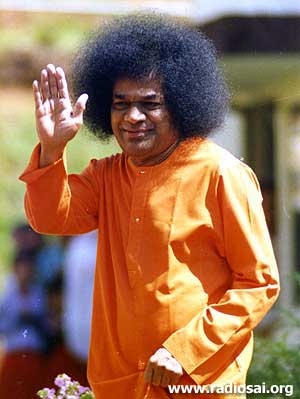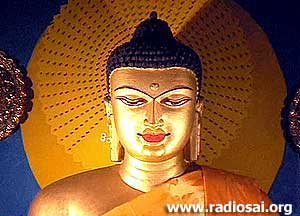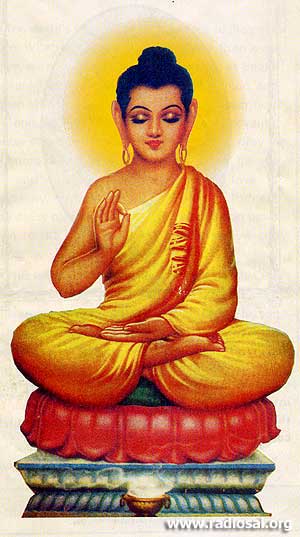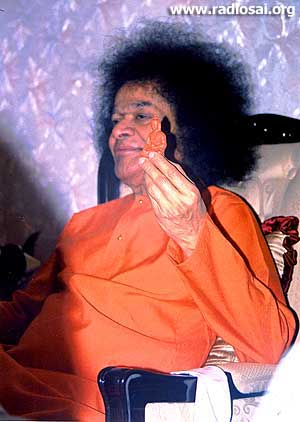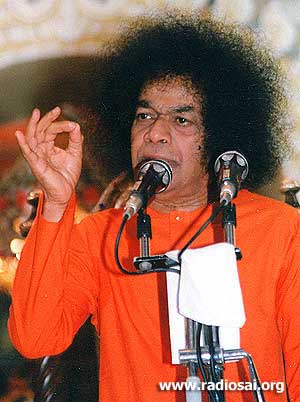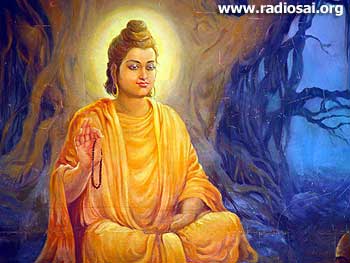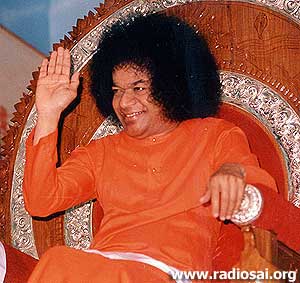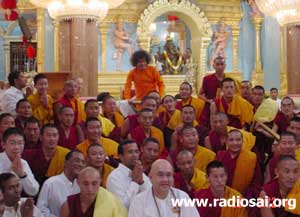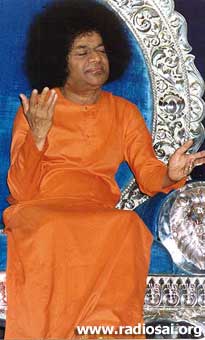 |
 |
 |
Volume
5 - Issue 05
MAY 2007 |
|
It is Bhagavan Sri Sathya Sai Baba who made me a better Buddhist today. I come from a family of several generations of Buddhists, who have aspired to follow the teachings of Lord Buddha through many centuries. I was myself wanting to be a renunciant but karmic influences made me a happy family man and eventually reach the top of my profession. I am called Ananda (meaning, bliss) and I try to remain true to my God-given name for this deha (body). I lost my father when I was barely 12 years old and he was only 47. It is this and many other adversities which made me an adult overnight filled with responsibilities to look after my widowed mother. We became instantly poor. All siblings after me died young and I was so ill that when people attended their funerals they expected to see me in the coffin! My late parents used to tell me that I was always a very happy soul hardly caring even for food. When they insisted on feeding me, I kept on telling them that some blue coloured angel was always feeding me as I slept and that is why I was not hungry. Now I know who protected me in my childhood. Just before I was born, my mother was given a lottery ticket by a vendor who left it on her tummy saying that the baby will bring her luck. As fate would have it, the next day, on the day of my birth, my mother struck the first prize. With that, the first thing she did was to buy the nearby Buddhist temple building which was used on a rented basis by the monks and donate it to the Sangha. Then she bought the hotel which we were renting, with which we were then able to make our living. Kept Alive Through Grace As much as I was deemed to have brought ‘good fortune’, I also troubled my parents being born with a hole in the heart. Thank God it was not in the head! Why? Each time Bhagavan Baba stood by my bedside before and after surgery. And He was ever present in my thoughts although I was under heavy sedation: I would hear Him say "Cured". I realise now why I have had all these plethora of medical problems: I have always prayed to make this my last birth. So I understand this fast-paced Karmic clearance by Bhagavan Baba. The most significant spiritual awareness was kindled in me, when I came to the Feet of Lord Sai in 1967. It was Swami who personified the Great Love of Buddha, much more than I ever realised before. Bhagavan Baba, in His magnificent Divine Discourses, exemplified with characteristic simplicity, the greatness of Lord Buddha. For example, Bhagavan once related how Buddha always spoke from a sense of righteousness and justice. Swami highlighted this by relating the following story during a Buddha Poornima Discourse in 1999: The Way of the Buddha
"Once Buddha entered a village along with His disciples. A lady approached Him and requested Him to have lunch in her house. Buddha blessed her and accepted her invitation. Seeing this, many villagers, including the village headman, warned Buddha, saying, 'O Buddha, You are one of wisdom and have renounced everything. The lady, courtesan-dancer Ambashali, is not a woman of good character. It is not proper for You to have food in her house.' Buddha smiled and asked the village headman to come forward. Buddha, holding firmly the right hand of the headman, asked him to clap. The headman said it was not possible for him to clap since one of his hands was in Buddha's hold. Buddha said, 'True. It is possible to clap only when two hands come together. Likewise, it is possible to clap only when two hands come together. This lady cannot turn bad by herself unless there are men of bad character in the village. The men of this village are the root cause of her bad character.' The villagers realised their folly, fell at Buddha's Feet and sought His forgiveness. Through His teachings, Buddha instilled sacredness and wisdom in people. Buddha's teachings are highly sacred, with profound inner meaning." Buddha's view of life is like that of a doctor. He provided individual solutions according to circumstances of those who came to Him for help. For example, when a distraught woman came to Him carrying the corpse of her son, asking him to give it life, the Buddha said that He could do so only if she found the necessary medication. When the lady exclaimed that she would search everywhere for this elixir of life, Buddha asked her to find a mustard seed from any house where none have died. She immediately started running from house to house but to her dismay, everyone told her that they had experienced at least one death in their family. Finally it dawned on her that death is inevitable! This is how Buddha taught self-realisation. Buddha’s Prognosis and Panacea
To help His followers attain wisdom and liberation, He offered a diagnosis through the Four Noble Truths. They are, (in Pali):
The word Dukkha is one of those Pali terms that cannot be translated adequately into English by one word. ‘Suffering’, ‘ill’, ‘anguish’, ‘unsatisfactoriness’ are some favourite renderings. The words pain, misery, sorrow, and so forth, are also used. The word Dukkha, however, includes all this and more. In Buddhism, awakening from ignorance to full knowledge always implies the comprehension of the Four Noble Truths. The Enlightened One is called the Buddha (the Awakened One) simply because he understood the Truths in all their fullness. The whole of His first discourse (Sutta), given to five ascetics at Saranath, is devoted to the formulation of these Truths; for they are the very essence of the Buddha's teachings. Without a clear idea of the Four Noble Truths, one cannot understand what the Buddha taught for forty-five years. To the Buddha, the entire teaching is just the understanding of Dukkha, the unsatisfactory nature of all phenomenal existence, and the understanding of the way out of this unsatisfactoriness. Our beloved Bhagavan in a Divine Discourse on 30 May 1989 said: "Buddha was born in this sacred land of Bharat (ancient India). He declared to the world Ahimsa paramo dharma (non-violence is the greatest of dharma). He undertook penance for several years, met many noble souls, listened to spiritual discourses, and studied various scriptures. But He was not satisfied. Man aspires for bliss, but how can he attain it? Where there is faith, there is love. Where there is love, there is peace. Where there is peace, there is truth. Where there is truth, there is God. Where there is God, there is bliss. The path of spirituality starts with faith and ends with bliss. Bliss cannot be attained from materialistic pleasures or from people of the world. It can be experienced only when the five senses are put to proper use." The Human Condition
What the Buddha taught during his ministry of over four decades embraces these Truths, namely: Dukkha, suffering or unsatisfactoriness, its arising, its cessation and the way out of this unsatisfactory state. One who thinks deeply will interpret these Truths as the goal of man’s life, his final deliverance; that is the sum total of the Four Truths. What we call man, in the ultimate sense, is a combination of mind and body, or the ‘five aggregates of clinging’ (through the senses and the mind) . On the human plane Dukkha does not and cannot exist independently of man, his mind and body. It therefore becomes clear that Dukkha is nothing else but man himself. So the first Truth is suffering, as the Buddha said: 'The five aggregates of clinging are Dukkha'. Then we know that the second truth is Tanha, Craving or Thirst, which is the arising of Dukkha. Now where does this Craving arise? Where the five aggregates of clinging are, there this craving arises. The third is the Stilling, the cessation of this Craving, Nirvana - the final deliverance. This, too, is not external to man. The last and the fourth Truth is Magga or the Way out of this unsatisfactory state, this repeated existence or Samsara. In this life, the man who enjoys pleasures of the senses is not liberated from samsara. As long as his craving and attachment are not extinguished, he clings to the aggregates and to things pertaining to them. The liberated one, however, experiences the bliss of Nirvana here and now; for he does not cling to sense objects; his craving and attachments have ceased and therefore, for him, there is no more continuity of aggregates, no more repeated existence, or samsara. The Practice of the Noble Eightfold Path This last and the fourth Truth is what is referred to as the Noble Eightfold Path (Arya Ashtanga Marga). In the Four Noble Truths, as you may have realised, the Eightfold Path is the only aspect which deals with practice. Whatever there is to be cultivated in Buddhism, comes within the scope of the Eightfold Path. This Path is a summary of the means that enable one to get out of this tangle of samsara, and realise Nirvana which is the only unconditioned Dhamma (ultimate truth) in Buddhism. Hence, it is necessary to bear in mind that the Path does not function as the cause and condition of Nirvana. It is only a means to it. Buddha recommended a lifestyle which followed all these eight principles:
Bhagavan Baba explains that Right Vision is the first and foremost step, without which nothing can be achieved. Right Vision or Right Understanding is to look at every situation with a Dharmic view. In a Divine Discourse on 5 Feb 1998, Swami said: "…Hence, Buddha declared that the first requisite is Samyak Darsanam (Having the right vision). The implication of this statement is that, having been bestowed with the great gift of eyes, man should use them for seeing sacred objects and holy beings. But on the contrary, by using his eyes to look at unsacred objects and evil persons, man fills himself with bad thoughts and becomes prey to evil tendencies. What one sees, influences the feelings in the heart. The state of the heart determines the nature of one's thoughts. The thoughts influence one's life. Hence, to lead a good life, the first prerequisite is pure vision. Man has to cultivate a sacred outlook. As a result of looking at cruel, ugly, and wicked scenes man leads an animal existence. The first inquiry one should make is to ascertain what is pure, edifying, and godly that he should see. Whatever he sees leaves its imprint on man. Few realise the effects of this." Cultivating the Ennobling Path As this Noble Eightfold Path is the only aspect of the Buddha's teaching which deals with practice, one has to focus all their attention on this practical teaching, for, theories and speculations are of no avail to one genuinely bent on practising the Dharma. There are no short-cuts to real peace and happiness. As the Buddha pointed out in many a Divine Discourse, this is the only path which leads to the summit of the good life, which goes from lower to higher levels of the mental realm. It is a gradual training, a training in right thought, word and deed which brings about true wisdom culminating in full enlightenment and the realisation of Nirvana.
It is a path for all, irrespective of race, class or creed, a path to be cultivated every moment of our waking life. As our beloved Swami exhorts, "All are One, be alike to everyone." Swami said in a Divine Discourse on 5 February 1998: "Buddha emphasised goodness in action (samyak-karma). The mark of good action is harmony in thought, word, and deed. When there is no such harmony, the action belies what is said or thought. Buddha went on to declare that good action is conducive to good spiritual progress (samyak-sadhana). Good deeds constitute genuine spirituality. Mere formal worship or ritualistic practices do not constitute spiritual striving. These religious practices are good in a way but they do not constitute spiritual sadhana. True spirituality consists in the unity of thought, word and deed in all their purity and sacredness. Buddha declared that when spiritual striving of this nature has been completed, there is samyak - jivanam (leading a pure life)." The Buddha, the Compassionate Teacher, is no more, but He has left a legacy, the sublime Dharma. The Dharma is not an invention, but a discovery. It is an eternal law; it is everywhere within each man and woman, Buddhist or non-Buddhist, Eastern or Western. As Swami exhorts, the Dharma has no labels, it knows no limit of time, space or race. It is for all time. Each person who lives the Dharma brings it to light, sees and experiences it himself. It cannot be communicated to another, for it has to be self-realised. The Buddha Gotama discovered the Dharma, as did his predecessors, the Buddhas of the past. Mere rejoicing and inspiration cannot lead them to the desired goal. Hence the need to cultivate the Path: "Be loving and be pitiful -Psalms of Early Buddhists, The Brethren. In a Divine Discourse on 5 Feb 1998, Swami stated: "Buddha stressed the need for Samyak Vak (sacred speech). anudvegakaram vakyam sathyam priya hitham cha yat. (One should speak only those words, which cause no annoyance to others and which are truthful, agreeable and wholesome). Whatever you speak should not cause any disturbance to others. It should be truthful as well as pleasing. You cannot always oblige but you can speak always obligingly. Under any circumstances, do not let your speech be tainted by harshness. Never become agitated. When you understand that all are one, there will be no chance to get angry. All bodies are like mirrors, showing your own reflection in them. How can you be angry with your own reflection? You should speak with love. There is no divinity greater than love. When you fill your heart with love, your thoughts, vision, words and deeds will be suffused with love." Throw Away the Teaching!
To explain the idea of all these sacred principles that are meant to lead to the ultimate goal, the Buddha used the simile of a raft. Let us listen to Him: “Using the simile of a raft, monks, I teach the Dharma designed for crossing over and not for retaining. Listen and attend carefully to what I say. Monks, man sets out on a journey and comes to a vast stretch of water. The near bank is dangerous, the far bank is safe. But no boat goes to the further shore and there is no bridge. He thinks: Vast indeed is this stretch of water, the near bank is unsafe but the further one is without danger. I had better collect grass, leaves, branches and wood to make a raft and with its aid, using my hands and feet ferry myself across to the further shore. Having crossed, he thinks: this raft has been very useful, for with its aid I have reached the further bank safely: I had better carry it on my head and go wherever I want to. What do you think, monks, if he does this, is he acting rightly about the raft? Suppose that man who has crossed over to the further bank should think: This raft has been very useful, with its aid I have reached the further bank safely: I had better beach it, or let it float down the vast stretch of water, and then go wherever I want. If he acts thus, monks, he would be acting rightly about the raft. Even so, monks, using the simile of a raft have I taught the Dharma designed for crossing over, and not for retaining. You, monks, who understand the Dharma taught by using the simile of a raft, have to give up good things (Dharma); how much more the evil things (Adharma).” Therefore, it is very significant to understand that the noble Eightfold path that the Buddha so passionately preached is never the goal. It is only a means to the goal. In the Buddhist texts one can find so many verses which beautifully portrays the path one treads towards the goal in Buddha’s own words: "Irrigators direct the water, -The Dhammapada "Declared is the straight path - Theragatha "This is the path itself, -The Dhammapada "Hunger is the greatest malady, -The Dhammapada In a very revealing discourse that Bhagavan gave in February 1998, He dwelt in detail on this “Bliss Supreme” that the Buddha was a personification of, and then recounted His last moments before leaving this physical realm. Swami said: "In His last moments, Buddha summoned His stepbrother Ananda to impart to him His final message. ..........Placing His palm on the head of His younger brother, Buddha said: 'My dear child! I came to the world to teach the Truth. If anyone asks, ‘Where is God?’ The answer is: ‘He is everywhere.’ Truth is God. Speak the Truth. Do not harm anyone. Recognise that the highest dharma is non-violence, Ahimsa." I am truly blessed to come under our most Beloved Swami's Grace for He has made me understand the supreme pure Love of Buddha. Swami has made me love Lord Buddha more. Buddha Poornima or Vesak is considered a thrice blessed day by Buddhists. It is the first full moon night of May. Significantly, the Buddha was born, attained Enlightenment and passed away on a Full Moon day in May. Gratitude to God
The first value Buddha taught the world is Gratitude. After attaining Enlightenment, the Buddha gazed at the Bodhi Tree for seven days with Loving Kindness. He was showing his gratitude to the Tree which provided Him shade, shelter and protection from inclement weather helping Him to realise Enlightenment. Similarly, how much more should we be ever grateful to our lovingly merciful Swami for all the love, healing and protection He continually bestows on His devotees? Baba says that He spends every moment of the day and night thinking how best to serve His devotees! I am alive today because Swami is always with me, above me, in front of me, behind me and next to me, constantly guiding me with His Divine teachings and healing me from multiple health problems. I was born with a hole-in-the heart. In spite of surgery, the heart murmur still persists to this day, at 68 years of age - but I gladly convert it to keeping rhythmic Namasmaran (chanting His Name). Even my doctors are surprised that I rebound so fast from various operations. Do they know that it is my Lord Sai who keeps me going? Swami acknowledged this in an Interview He granted me on Thursday August 19, 2004. He is the OM He is there physically all round as He emphasises always – “I am there in you, around you, above you, below you, behind you, all round you”. For me Baba is Buddha-Sai returned to salvage mankind. I constantly feel His presence.
Even in office as Director of News and Public Affairs of the Singapore Broadcasting Corporation, I had an altar in front of me with two large pictures of Shirdi Sai, Parthi Sai and a Buddha statue. Each time I worked on a project, I would prostrate before Baba's altar and ask for guidance. Is it a wonder that the programmes I offered at Bhagavan's Lotus Feet won the most number of International Awards for Singapore in major competitions which had the leading nations of the world lobbying to win these accolades? Almost a hundred nations vied for some of these coveted prizes. He is my Swas - my very breath. I had the divine opportunity of thanking Him for all His Divine Guidance and Protection in His Holy physical Presence. He smiled and blessed me with Abhaya Hastha - raising both His Holy Hands! Last year, he gave my wife and I the divine privilege of doing Arathi on Gurupoornima day. Again, this year, I had the opportunity of singing at Sai Kulwant Hall and also tasted the holy vibhuthi just manifested by His most Divine Hands! Capt Ong and Sister Meng Meng made all the arrangements to visit various Tibetan temples and ensure that the monks would come on the scheduled dates given by Bhagavan.
Of course, He revealed that He is the OM - Omnipresent, Omnipotent and Omniscient when He revealed certain aspects of my life which only my physical mother knew - but my Divine Mother knew it all and more. He encouraged me to sing bhajans. I am doing so at least three times a week regularly, sometimes accompanying myself and others on the tabla (percussion instrument). I did not play the tabla for over 40 years. All my fingers were affected by arthritis and I had them all operated with the medical advice not to stress them.
But when requested to play the tabla as our bhajan centre was badly in need of one, I repaired the tabla, placed it in front of Swami's altar, prayed and played. Immediately, my fingers outstretched themselves in holy glee to provide rhythm for the bhajans. I felt His Divine presence the moment I hit the first note. Baba had earlier made me a child artiste on TV and Radio singing in all five languages: my mother tongue Sinhala, Tamil, Hindi, Malay, English and Chinese. Isn't Baba ever present in our lives? I used to place a chair in front of the altar in my office room - to place all important assignments for Baba's Guidance. Inevitably, the next morning the answers over-flowed. I breathe, live, eat, sleep with thoughts of Bhagavan in Constant Integrated Awareness. Given my many health problems, I almost had a Permanent Resident status at Singapore General Hospital (SGH). I never realised how much SGH would mean to me during the past 6 years, as I know now that SGH means Sai Global Harmony Radio which to me is the constant umbilical cord to God. Maithree Buddha is Already Here! And I am eternally grateful to my Beloved Master - not only for the continuous healing but also for teaching us how to be in the Joy of Constant Integrated Awareness! We Buddhists are indeed very fortunate to celebrate Buddha Poornima in the Divine Presence of Bhagavan Sri Sathya Sai Baba. Many Buddhists await the arrival of Maithree (Compassionate) Buddha. As for me, as I mentioned in an Interview on Radio Sai Global Harmony, Maithree Buddha is already here. ''My three buddha" is a combination of Shirdi Sai, Sathya Sai and Prema Sai! Let us make the most under His Divine Guidance and Protection. Sabbe Sattha Bhavantu Sukitattha (Pali) that is, May all sentient beings be well and happy! Sairam. Dear Reader, did you find this article helpful? Do you have any experiences that you would like to share with us? Please contact us at h2h@radiosai.org mentioning your name and country. Thank you for your time.
|
| You can write to us at : h2h@radiosai.org |
Vol 5 Issue 05 - MAY 2007
|
Best viewed in Internet Explorer - 1024 x 768 resolution. |

